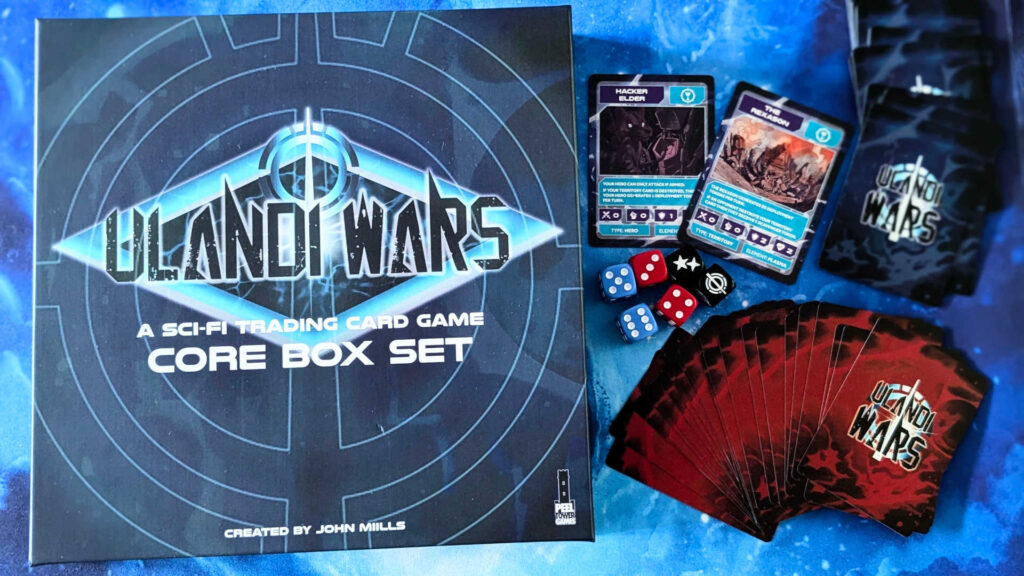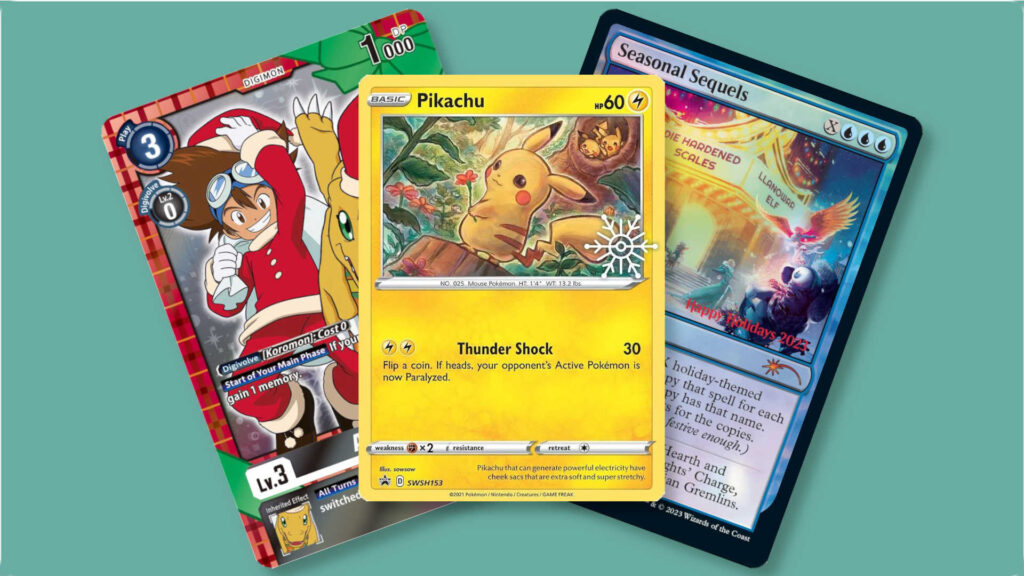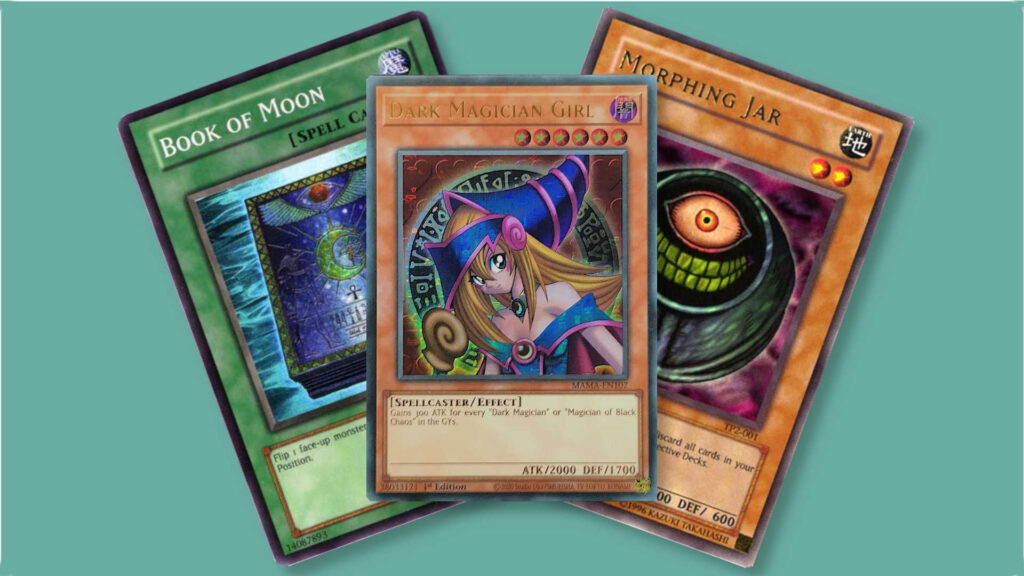It’s a great time to be a fan of trading card games (or TCGs) right now; as well as plenty of high profile titles that have been recently released or are on the way, such as Riftbound, numerous games from small, independent publishers are regularly making their way to shelves and tabletops worldwide. Ulandi Wars, from Peel Tower Games, is the latest indie title we at Card Gamer have had the chance to delve into. So what is it about, and is it worth playing? Let’s find out!
Table of Contents
ToggleWhat Is Ulandi Wars?
A sci-fi TCG, Ulandi Wars is set in the eponymous Ulandi universe, and sees each player embodying one of four factions vying for supremacy. Though, like most TCGs, Ulandi Wars is primarily designed for 1v1 play, rules are included in the Core Box Set for different ways to play with 3 or more players involved.
Getting Started With Ulandi Wars
In order to play a game of Ulandi Wars, you’ll need the aforementioned Core Box Set. This contains the comprehensive rules, four faction decks, an Event deck (more on that shortly!), plenty of tokens of various types, wound tracker discs and, finally, various dice (standard six-sided dice, along with special ‘smash’ dice). Each faction deck has cards with different colored backs; blue-backed cards are Infrastructure, and cards with red backs are Wargear.
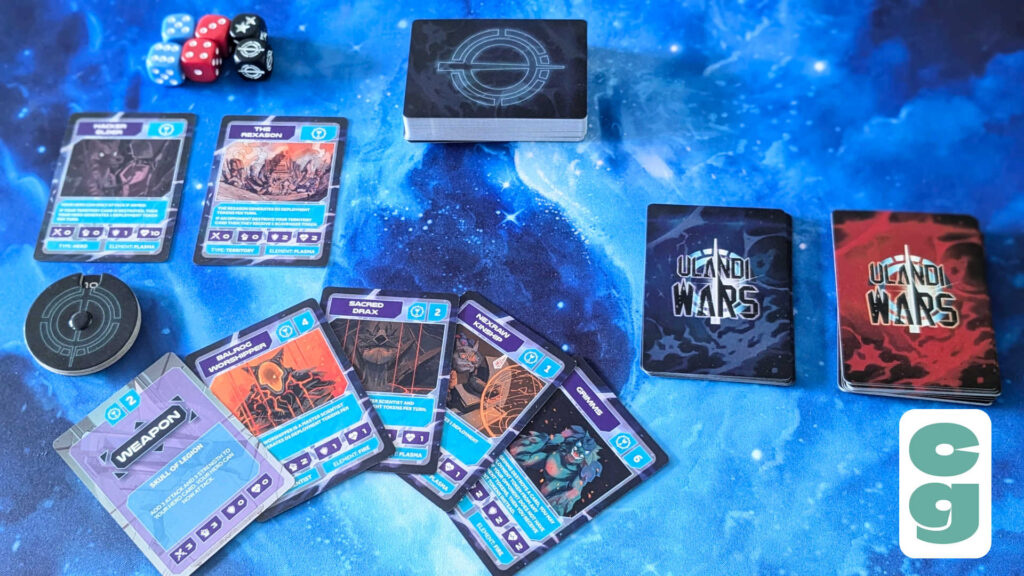
To begin the game, the Event deck is shuffled and placed within reach of both players. Then each player chooses a faction’s Battle Card Deck and removes their Hero and Territory cards (also known as a player’s Command cards), which are then placed face up in their play area (referred to in the rules as the Combat Zone). Players then shuffle their Infrastructure and Wargear decks separately, and draw 5 cards to begin.
Intriguingly, it’s entirely up to each player as to how many cards they draw from each of their two decks; if they choose to draw all 5 from just their Wargear or Infrastructure deck, they can do so, but any combination of the two up to 5 cards in total is permitted. A first player is chosen by the highest roll of a six sided die, then play can begin.
How to Play Ulandi Wars
There are five phases to each player’s turn in Ulandi Wars. Phase 1 is the Token stage, where the active player removes all Just Deployed tokens from cards played on their previous turn (meaning that these cards are now active).
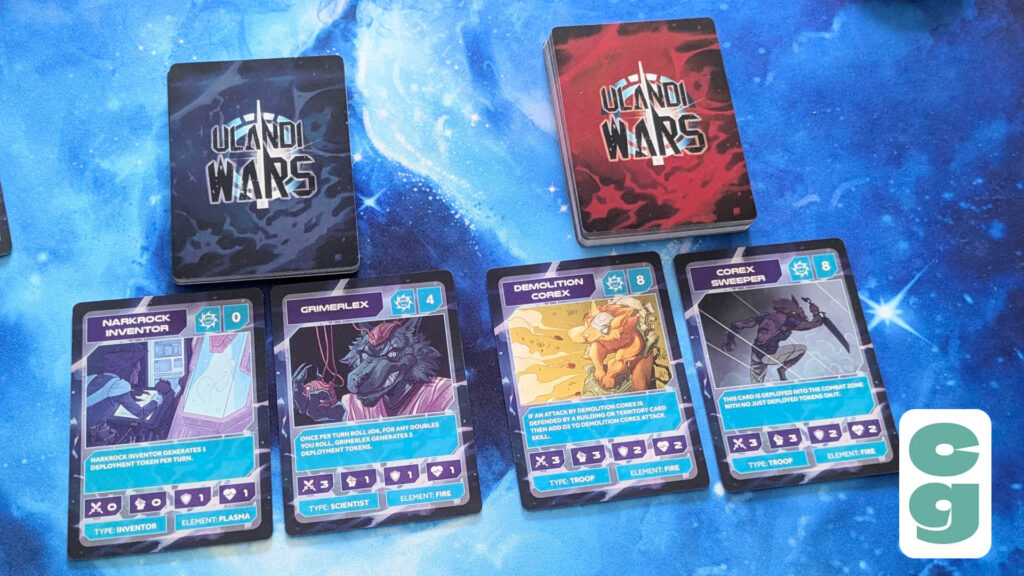
The Draw stage is next, and here players draw 1 card; this can be from either their Wargear or Infrastructure deck. Wargear cards are typically combat-focused, whereas Infrastructure cards lean towards providing more deployment tokens, which are used to play cards from your hand.
The active player then draws an Event card to hand, though if it’s an Effect, rather than a Reward or Upgrade, it is resolved immediately. Upgrades can be used during combat and Rewards are cashed in as soon as the condition on the card is met (which can be during almost any phase of the game!). You can see an example of each Event card type below.
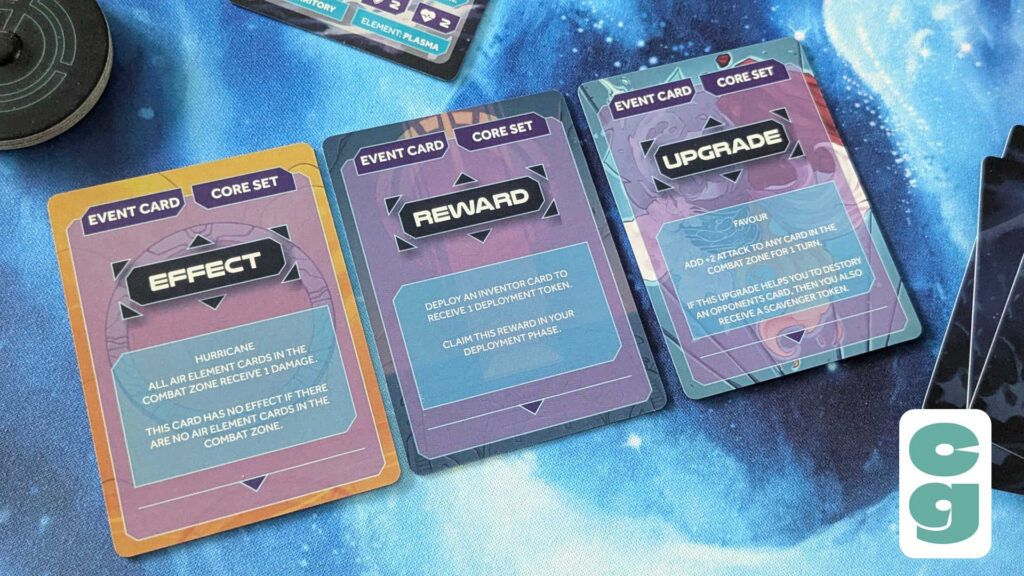
It’s in Phase 3, Deployment, that the deployment tokens are used; here, players can play as many cards as they like from their hand, providing that they have enough deployment tokens to pay for them. Each card’s deployment token cost is on the top right, next to their faction symbol, and when deployed a card is placed in the Combat Zone and has a Just Deployed token placed on it. As you’ll recall, these are removed in the Token stage of your next turn! It’s worth noting that, not including the Leader and Territory card, that there’s a maximum of 6 cards allowed in each player’s Combat Zone.

You can earn Scavenger tokens if you discard a card from a Combat Zone that’s full, in order to play a new card. You earn 1 Scavenger Token whenever you do this, and each Scavenger token can increase a card’s chosen skill (attack or defense) by 1 point. In the example above, the Scavenger token could be used to raise the Rokhorn’s attack to 4, or its defense to 3.
Phase 4 is Combat; here, you’ll choose which cards in your Combat Zone will attack your opponent (only cards without Just Deployed tokens may attack). The opponent chooses which cards of theirs will defend against which attacking cards; note that if no defenders are declared, or if the attackers outnumber the available defenders, any undefended attackers will attack the opposing Hero directly.
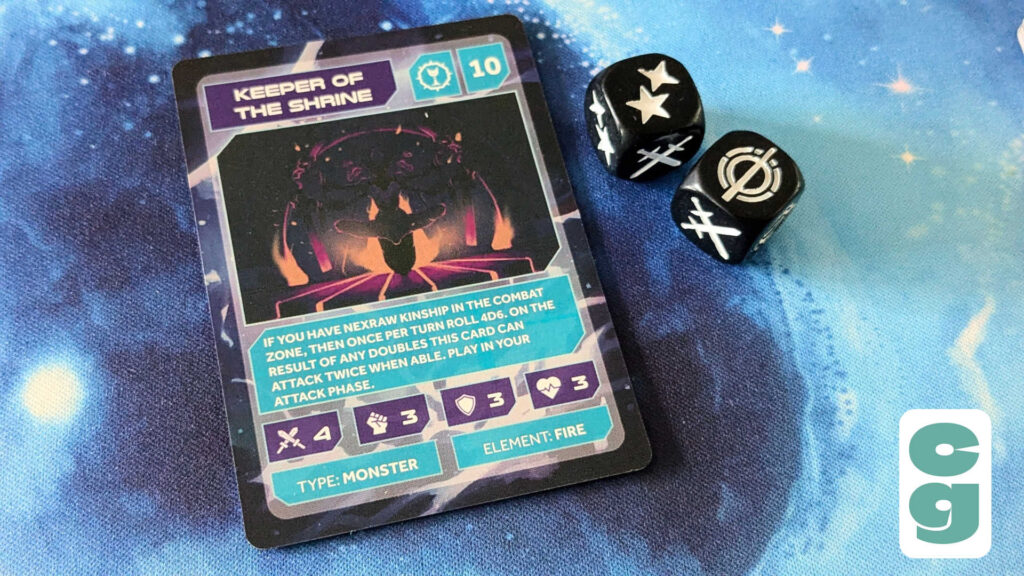
Upgrade event cards can be played by both players to bolster their cards, and some card types (Tanks and Monsters, specifically) will roll a Smash Die for a potential bonus, before their attack takes place. Cards with zero attack value can’t attack (unless they have a Weapon or other bonus which gives them at least 1 point of attack), and the same applies to defenders with 0 defense value.
Combat is straightforward; the attacker rolls a six sided die for the first card they choose to attack with, and adds the result to the card’s attack skill. The defender also rolls a six sided die, but adds their result to their card’s defense skill. The highest number of the two results wins, and the winner deals their strength value as damage to the losing card.

In the example above, the active player used a Corex Sweeper to attack; with no other defenders, the other player was forced to defend with theirLeader, the Hacker Elder. The Hacker Elder can’t attack as it has an attack value of 0, but it can defend given that its defense is 1. The Corex Sweeper attacking was a risky move, as it already has 1 wound, meaning that it has 1 left before it is destroyed; however, it has a good chance to deal damage because its attack value is 3.
If this means that the loser’s wounds are reduced to zero or less, it is discarded; otherwise, wound tokens are placed on the card, until it is either destroyed or, using certain card effects, healed.
The final Phase is the End stage, in which the effects of certain cards resolve, and any unresolved Reward Event cards are triggered. Play then passes to the next player for them to begin their turn at Phase 1. If at any point a player reduces their opponent’s Hero card to zero wounds or less, they win the game. In a game with more than 2 players, the last player or team with all Hero cards remaining win the game.
Is Ulandi Wars Fun to Play?
The gameplay of Ulandi Wars features some really unique touches that make it stand apart from other TCGs. The choice of decks adds an extra layer of strategy to drawing a card, and Events, along with the dice rolls, add just enough randomness to keep things interesting, without succumbing to chaos.
This in itself is quite a delicate balancing act; whereas some games rely too heavily on random elements such as dice rolls, Ulandi Wars feels as if it has exactly the right mix of tactics vs luck, allowing for the occasional upset during combat, or advantage in card draw, but this serves to make the game more exciting rather than frustrating.
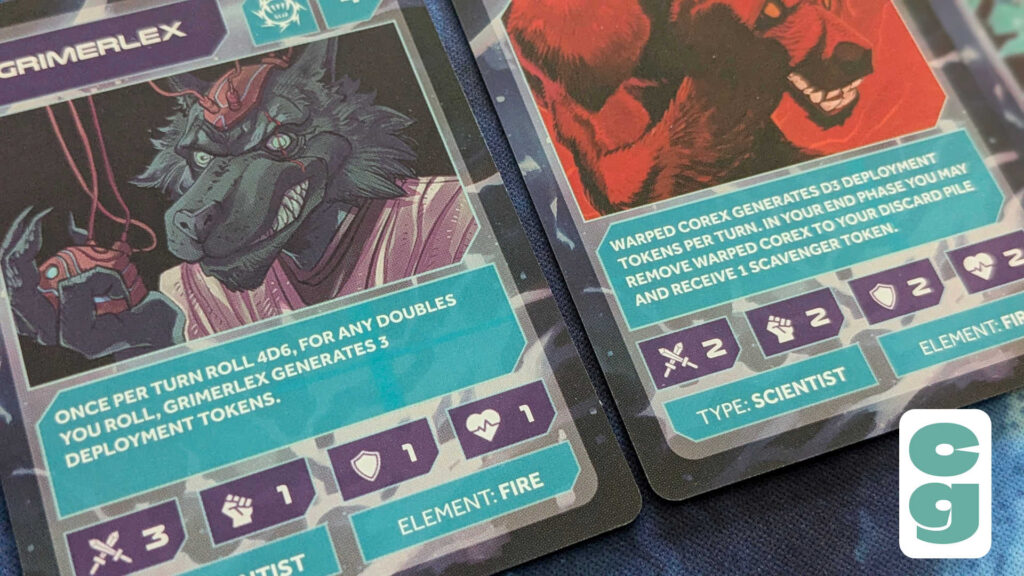
There’s a few things I’m not hugely enamored with; for example, some of the card art is a little murky and undefined, and I do wish that deployment token generation was handled with an extra stat box symbol and number, rather than being text-based (though admittedly, if you look at the examples above, some of the conditions around deployment token generation can be complex). Similarly, I think the Smash Die bonus could have been shown with a symbol, rather than needing players to remember to check a card type before attacking. Weapon cards lacking card art is also initially disappointing, though it’s understandable given that the section of the card which would feature art is hidden when the card is ‘attached’ to another card during play anyway.
However, just about all of these elements that I found fault with feel as if they’re personal preference rather than being dealbreakers. Any hindrance these nitpicks (and they really are nitpicks) present to the fast moving gameplay of Ulandi Wars is minimal, and there’s a lot of thoughtful touches, and excellent presentation (including deck boxes for each Faction and the Event deck), which counterbalance these points.

The turn structure is smooth and very easy to pick up, as are the rules in general. The pace of Ulandi Wars is impressive too; not only does the game move quickly, but it’s exciting every step of the way, with the risk vs reward of combat being particularly dramatic and satisfying.
Though the Core Box Set is enough to get you started, and to play numerous games with the fixed decks (with each deck also available separately), it also does a good job of whetting the appetite for more cards and sets. There’s already a small selection of extra cards, including further Events, available now, directly from the official Ulandi Wars website.
There’s an impressive amount of background content for you to delve deeper into the Ulandi Wars universe beyond the game too, with a novel, stories and more besides; the Ulandi Wars Core Box Set is a great starting point, for a universe that hopefully continues to expand and build upon its very solid foundation.
The Card Gamer Verdict
It’s a great start for a new TCG, and it’s a testament to the game’s strong design that I found Ulandi Wars to be engaging almost immediately, despite the lack of familiarity with its settings and characters.
Though Ulandi Wars is easy to learn and play, I had a few (admittedly minor) issues with presentation of certain elements; that said, the game is generally very well designed and accessible to players of any age or skill level.
Despite being a small, independent company, Peel Tower Games have done a fantastic job with their creation of an entirely new IP; the fresh gameplay and clever mechanics of Ulandi Wars can stand proudly alongside many other, bigger budgeted TCGs.
You can buy the Ulandi Wars Core Box Set, along with other products such as extra cards and the first Ulandi Wars novel, directly from the Ulandi Wars website.
Want to check out other indie card games? Take a look at our reviews of Achroma, The Game Chest and House of Cards.


